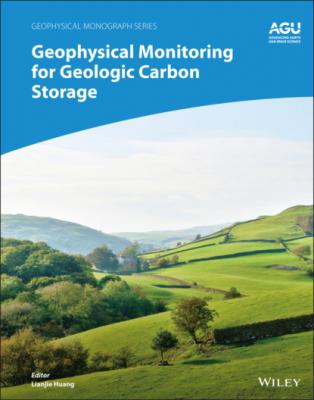Geophysical Monitoring for Geologic Carbon Storage. Группа авторов
Чтение книги онлайн.
Читать онлайн книгу Geophysical Monitoring for Geologic Carbon Storage - Группа авторов страница 48
 5.2 Modeling parameters
5.2 Modeling parameters
| Parameter | Symbol | Value |
|---|---|---|
| Undrained frame Young's modulus | E U | 20.5 GPa |
| Matrix frame shear modulus | G | 7.60 GPa |
| Matrix Biot‐Willis effective stress coefficient | α | 0.769 |
| Matrix porosity | φ | 16.7% |
| Mineral bulk modulus | K s | 38 GPa |
| Mineral density | ρ s | 2,650 kg/m3 |
| Water density |
|
989 kg/m3 |
| scCO2 density |
|
535 kg/m3 |
| Water bulk modulus |
|
2.46 GPa |
| scCO2 bulk modulus |
|
0.04 GPa |
| Sample length | H | 10.0 cm |
| Sample diameter | a | 3.81 cm |
| Fracture aperture (core parallel) | h | 0.54 mm |
| Fracture aperture (core perpendicular) | h | 0.26 mm |
Note: Unlisted poroelastic parameters such as α , B, K U , K D , E D , M are derived from these parameters using Gassmann relationships for isotropic poroelastic media. The fluid bulk modulus K f is given as a function of the scCO2 pore saturation
The rock’s effective stress coefficient α is computed from undrained bulk modulus K U = E U G / 3(3G – E U ), K f , and the porosity φ via
The abrupt changes in the attenuation can be explained by coexisting two attenuation mechanisms. The first mechanism is the effect of the heterogeneous and patchy scCO2 distribution in the rock matrix, as seen for the intact cores. As assumed by the patchy‐saturation model (e.g., Azuma et al., 2013), pressure in these patches does not equilibrate with the water in the surrounding rock if ultrasonic waves are used for the measurements (i.e., there is no fluid flow across the boundaries). However, with the current, sonic‐frequency measurements, seismic waves cause higher pressure within the stiff, water‐saturated part of the rock, which drives the water toward the softer, scCO2‐saturated part. With increasing volume of the rock where the two fluids coexist, the overall attenuation of the sample increases as scCO2 is injected into the sample.
The second mechanism is the attenuation caused by the interaction between a high‐porosity, high‐compliance fracture and a lower‐porosity, low‐compliance rock matrix. At the initial, water‐saturated state, attenuation in the sample is large. This is because seismic waves induce enhanced pressure changes within the compliant fracture, which drives dynamic fluid exchange with the matrix and dissipates a large amount of energy. This attenuation becomes small once the compliance of the fluid in the fracture increases, and the fracture‐driven motions of the water in the rock matrix diminish.
This reduction is expected to be large if scCO2 fills the fracture faster than the surrounding matrix, resulting in similar wave‐induced pressures within the fracture and the matrix. As the CT images in Figure 5.9 indicate, this situation appears to be the case in our experiments: fast passing of the fluid is seen along high‐permeability sedimentary layers (Frac IIb test) and the sample‐Mylar interface (Frac IIa test). Figure 5.10 compares the scCO2 saturations for only the fracture and for the entire core for Frac IIb test. This plot indicates that when rapid changes in the Young's modulus and the attenuation occur (core scCO2 saturation ~5%–7%), nearly 50% of the fracture is already saturated with scCO2, although from the CT images, most of the matrix near the fracture is still fully saturated with water. The final saturation of the fracture is also much higher (~83%) compared with the average over the entire core (~17.5%). As more pores near the fracture are invaded by scCO2, because wave‐induced pore pressure in the matrix also decreases, the attenuation caused by the fluid movement between the fracture and the matrix increases again. Additionally, introduction of scCO2 in the second half of the core increases attenuation further.
The above effect can be examined semiquantitatively by comparing the changes in the Skempton coefficients of the fracture and the rock matrix during fluid substitution. Under uniaxial stress, assuming an undrained state (i.e., only the “driving force” of the fluid flow is examined here), pore pressure and axial stress in the rock matrix are related by
Figure 5.9 Young's modulus E and its related attenuation aE compared with the scCO2 distribution in Frac IIa and Frac IIb cores. The maximum decreases in E occur when scCO2 reaches the fracture but before the saturation in the adjacent rock matrix becomes high. Attenuation also drops abruptly at the same time. Green boxes indicate the responses due to possible relaxation of the